You're using an outdated browser. Please upgrade to a modern browser for the best experience.

Submitted Successfully!
Thank you for your contribution! You can also upload a video entry or images related to this topic.
For video creation, please contact our Academic Video Service.
| Version | Summary | Created by | Modification | Content Size | Created at | Operation |
|---|---|---|---|---|---|---|
| 1 | Giuseppina Pappalardo | -- | 3934 | 2023-10-09 11:08:48 | | | |
| 2 | Jessie Wu | Meta information modification | 3934 | 2023-10-11 10:19:54 | | |
Video Upload Options
We provide professional Academic Video Service to translate complex research into visually appealing presentations. Would you like to try it?
Cite
If you have any further questions, please contact Encyclopedia Editorial Office.
Wachnicka, J.; Jarczewska, A.; Pappalardo, G. Cycling Education in Europe. Encyclopedia. Available online: https://encyclopedia.pub/entry/49965 (accessed on 22 December 2025).
Wachnicka J, Jarczewska A, Pappalardo G. Cycling Education in Europe. Encyclopedia. Available at: https://encyclopedia.pub/entry/49965. Accessed December 22, 2025.
Wachnicka, Joanna, Alicja Jarczewska, Giuseppina Pappalardo. "Cycling Education in Europe" Encyclopedia, https://encyclopedia.pub/entry/49965 (accessed December 22, 2025).
Wachnicka, J., Jarczewska, A., & Pappalardo, G. (2023, October 09). Cycling Education in Europe. In Encyclopedia. https://encyclopedia.pub/entry/49965
Wachnicka, Joanna, et al. "Cycling Education in Europe." Encyclopedia. Web. 09 October, 2023.
Copy Citation
Owing to the active promotion of environmentally friendly lifestyles in several European nations, the bicycle is progressively emerging as a predominant mode of transportation on the roadways. This phenomenon can be attributed to a plethora of factors. Numerous cities are gradually prioritizing the development of sustainable transportation systems, which includes restricting car access to central areas. Moreover, there is a growing ecological awareness among individuals who are averse to contributing to urban pollution with vehicle emissions. Additionally, the bicycle offers a means of travel that enables users to maintain and enhance their physical health and overall well-being.
cycling safety
cycling education
cycling proficiency test
1. Introduction
Within the framework of international law, European nations are obliged to adhere to a series of treaties that govern road regulations. The 1968 Vienna Convention, in particular, encompasses all type of vehicles, including cyclists and pedestrians, within its traffic rules [1]. Some countries further elaborate upon these provisions with additional clauses that complement the Convention’s guidelines. These supplementary regulations primarily address aspects such as mandatory equipment to enhance cyclist visibility (e.g., pedal reflectors, spoke reflectors), standards for child bicycle seats (e.g., seat design, mounting mechanisms, footrests), the minimum age for cycling on public roads, and rules pertaining to helmet usage [2].
In countries boasting well-developed educational systems and robust bicycle infrastructure, young children are educated about anticipating hazardous scenarios on the road from an early age. They become acquainted with road signs and traffic regulations, which enables them to react appropriately. The responsibility for imparting road safety knowledge to children at an early stage lies with their family members. Recognizing that childhood perceptions, beliefs, and repetitive behaviors often solidify and prove resistant to change in the future, parents or guardians must prioritize cycling education and act as commendable role models [3].
It is imperative to note that a significant portion of a child’s physical development occurs before the age of 7 and continues to refine throughout adolescence. Cycling, being a fine motor skill, demands ample practice for the movements to become instinctive and well-coordinated. Riding within traffic involves two categories of motor skills:
- Fundamental bike handling skills:
-
Maintaining balance.
-
Pedaling.
-
Steering.
-
Braking.
2. Safety skills:
-
Scanning the environment (e.g., moving one’s head).
-
Merging into traffic.
-
Braking to halt at traffic signals and stop signs.
-
Signaling maneuvers when turning [4].
With this foundational context in consideration, let researchers delve into exemplary training systems found in various European countries. This examination of training systems and examination of school-age cyclists was conducted in a limited set of seven countries. This restriction was imposed due to the challenges associated with accessing the required information, which is often available in the native language of each respective country. Nevertheless, researchers' efforts were meticulous to ensure the inclusion of representative materials from countries with extensive histories of promoting cycling such as the Netherlands or Germany, as well as countries from the Eastern Bloc, where transformative shifts in transportation behavior are still in their nascent stages.
2. The Netherlands
The Netherlands stands out on a global scale as one of the most bicycle-friendly nations, renowned for its well-established cycling infrastructure and innovative approach to training young cyclists. In the Netherlands, the paramount importance of education in ensuring road safety has long been acknowledged for an extended period. This recognition has materialized through the introduction of road safety education courses within the school system. Notably, cycling education is a mandatory component of this curriculum and culminates in a cycling examination. While the theoretical examination is compulsory, the practical examination is at the discretion of individual schools, with approximately 80% typically opting to include it [5].
From an early age, parents instill safe cycling practices in their children, seamlessly integrating road rules into everyday play and activities. Dutch data reveals that children under the age of 11 cycle almost as frequently as they walk. Within the school curriculum, a dedicated subject on road safety exists, which must be successfully completed to advance to the subsequent grade level. Formal cycling education begins in elementary school and extends beyond mere classroom learning. A crucial aspect of this education involves biannual visits to a “traffic garden,” a purpose-built facility designed to simulate various traffic scenarios. Equipped with traffic lights, road signs, bike paths, roundabouts, and more, the facility serves as a practical training ground. These educational visits are led by trained instructors who initiate the lessons by explaining road regulations within small, specialized groups. Following this, students are divided into three groups: one group operates small vehicles, another cycles, and the third navigates the space as pedestrians. After approximately 20–30 min of practice, the groups rotate. Typically, these visits occur when pupils are around 10–11 years old, coinciding with their transition to junior high school [5].
Between March and June, seventh- and eighth-grade primary school students participate in the Nationaal VVN Verkeersexamen practical test on road bikes. This practical examination assesses students’ ability to apply theoretical knowledge to real-world situations and demonstrate their acquired road traffic skills. The examination takes place on a predetermined city route, with stationed police officers or volunteers who evaluate students based on a predefined checklist (refer to Figure 1). An illustrative route for the Verkeersexamen exam, complete with checkpoints, is depicted in Figure 2. The exam aims to closely replicate everyday cycling conditions; thus, no additional signage is placed on the route, nor are streets closed off to traffic. Well in advance, students and parents receive details about the exam’s structure and route to allow ample preparation for the tasks ahead. To participate in the Verkeersexamen, students must use an approved bicycle, adhering to specific requirements outlined in a provided folder distributed at school. A passing score on the Verkeersexamen necessitates achieving at least 80% of the available points. Exceptions arise in cases of critical errors, such as running a red light or disregarding right of way, which result in an automatic exam failure regardless of point accumulation. Results are typically delivered on the same day as the exam. Subsequently, teachers can discuss results individually or with the entire class, focusing on commendable aspects and areas for improvement. In cases of a negative outcome or illness, students are allowed another attempt within a 4-week timeframe, with the date being set by the school [6].
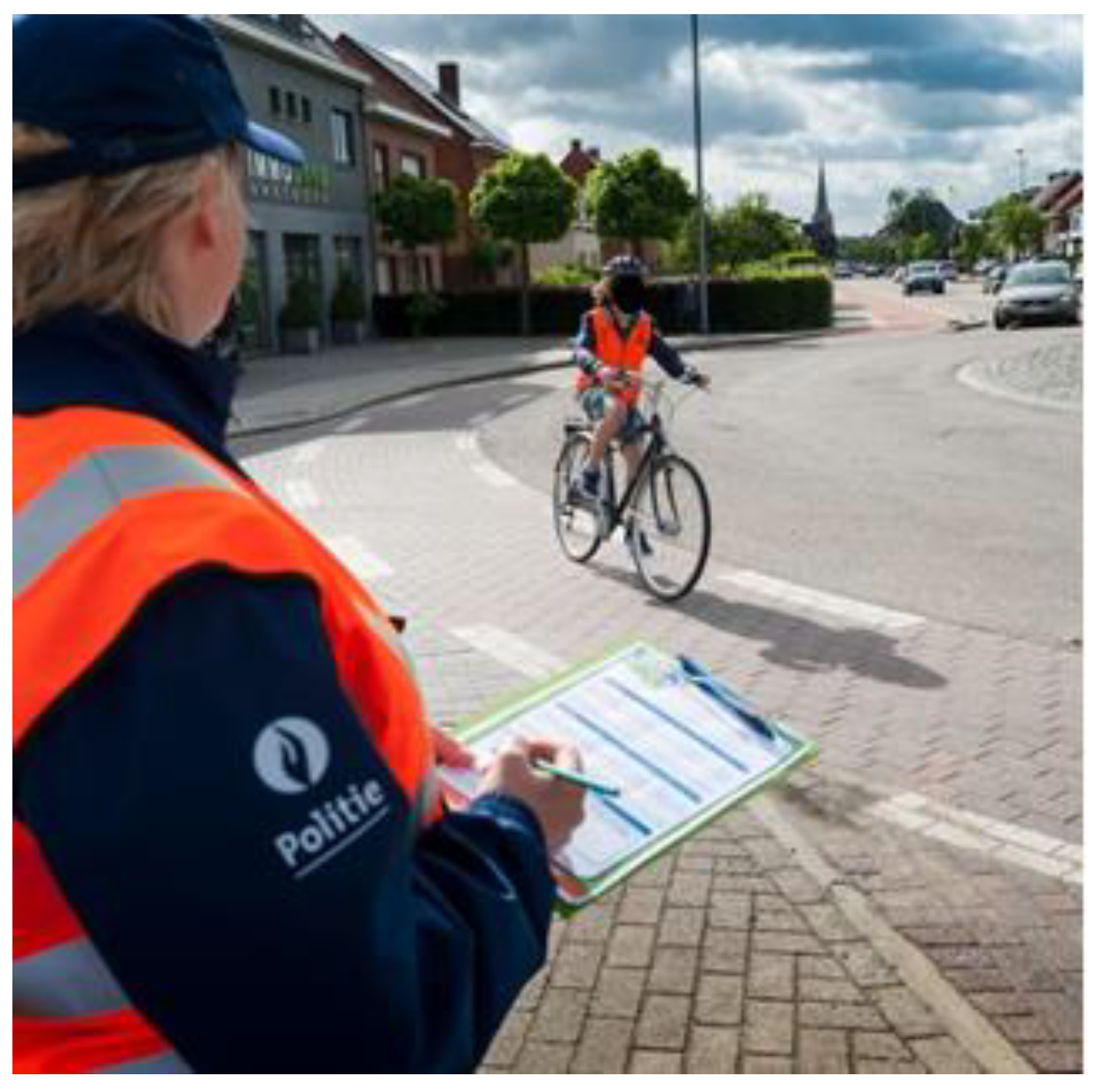
Figure 1. VVN road practical test [7].
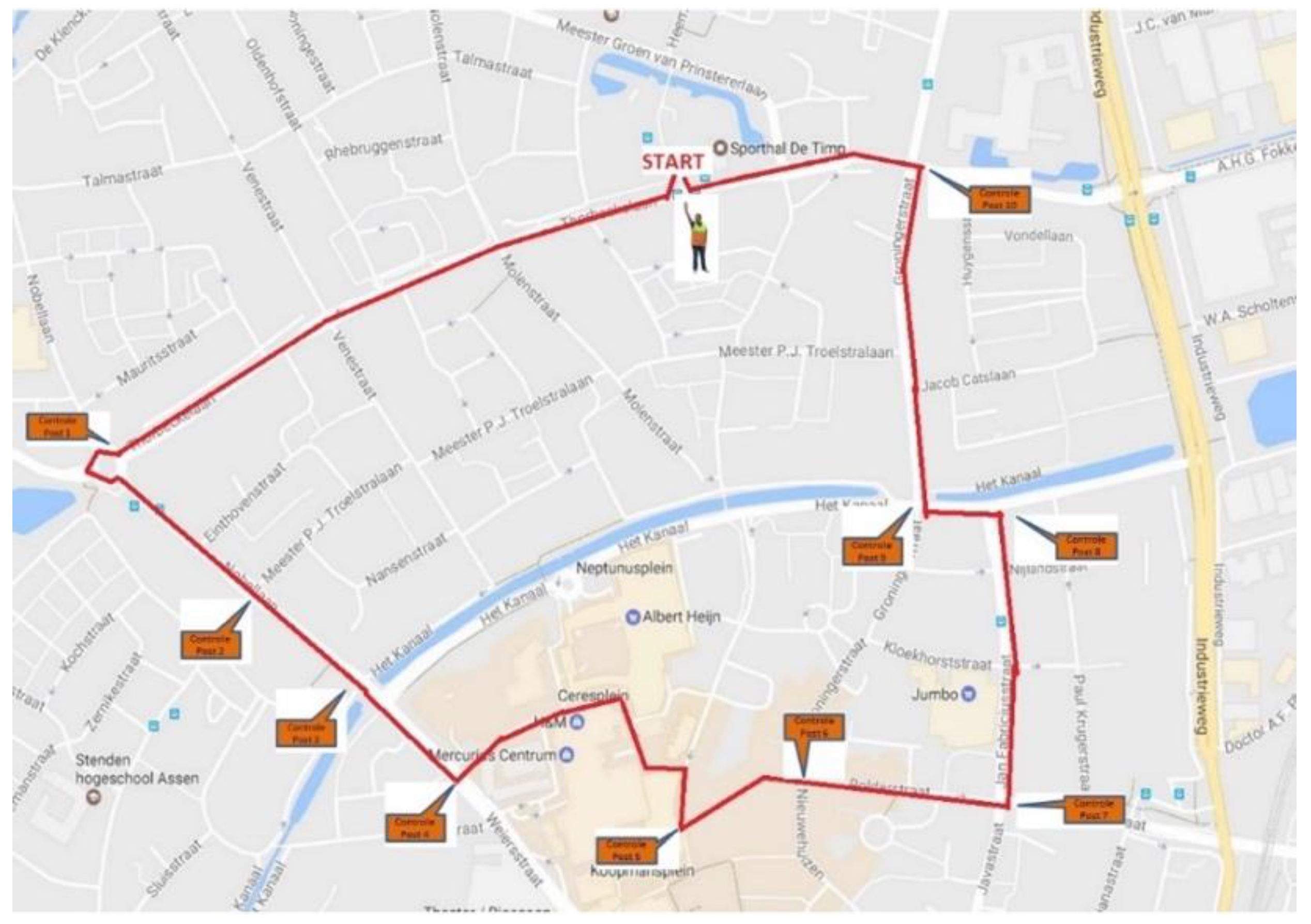
Figure 2. The route of the practical Verkeersexamen 2020 in Assen [6].
Moreover, to augment preparedness for the practical examination, the introduction of the VVN application has played a pivotal role. This application enables facilitating independent practice for children within the comfort of their own homes. Over a four-week period, the app provides guidance by offering instructional videos, assignments, and valuable tips that align with the examination format [6].
3. Germany
Germany boasts a well-developed traffic education system. Due to its federal structure, the responsibility for road education in schools lies within the jurisdiction of individual Länder (states). While these states have the autonomy to develop distinct curricula, the “KMK Recommendation on Road Education,” issued in 1972 within the Federal Republic of Germany, serves to standardize the content, scope, and teaching methods of road education [8]. The initiation of road education in Germany begins at the preschool stage, where foundational knowledge regarding road traffic participation is introduced through various exercises and interactive activities. Typically, by the first year of primary school, most Länder incorporate a dedicated subject into the curriculum, aimed at familiarizing young students with essential traffic-related behavior patterns [9]. A significant milestone in assessing the reaction of first graders to real-life road traffic situations is the pedestrian examination [9]. Upon achieving the Walking Diploma, German students commence preparations for the bicycle license examination, a process that begins in the second grade.
In schools, transportation education in schools is facilitated by specialized educators who impart theoretical knowledge concerning road education. The practical aspect of training (refer to Figure 3) is supervised by specialized police officers referred to as “traffic guards” at the Jugendverkehrsschule (youth traffic school) [10]. These institutions operate under the oversight of local traffic authorities, occasionally in collaboration with the police, and participation in their programs comes at no cost to the students. Practical cycling training is also often conducted within the confines of the school playground.
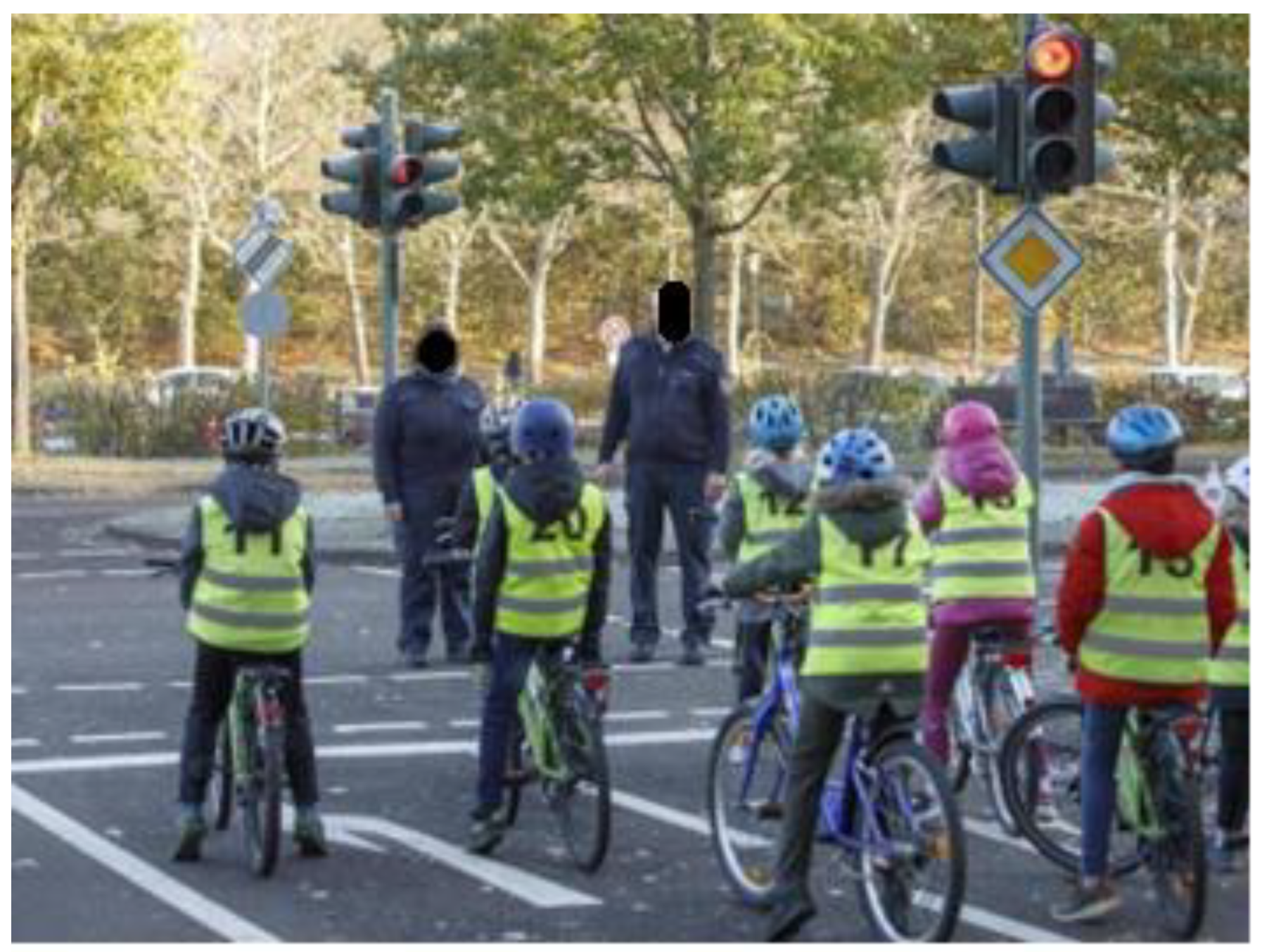
Figure 3. Practical part of the training [11].
Within Germany, the non-governmental organization Deutsche Verkehrswacht plays a pivotal role in advancing road safety education. This organization not only provides bicycle education within schools but also assists parents in nurturing their children’s sense of balance and motor skills, especially for those who are just beginning to learn how to cycle [12].
In Germany, the bicycle license examination, which encompasses both theoretical and practical components, primarily occurs during the fourth grade of primary school. Although participation in this examination is voluntary, it is taken quite seriously. The examination is conducted within the school courtyard, in simulated traffic settings, or most commonly, at the Youth Traffic School. Prior to the examination, participants have the opportunity for a practice run with police officers.
The formal part of the examination typically lasts for 15 to 20 min and involves the student navigating a designated route. In certain instances, children even have the option to choose their route. Should a test taker accumulate more than 10 penalty points, they are required to retake the examination.
The bicycle license awarded upon successful completion of the examination is symbolic in nature, as it does not grant immediate riding privileges. Germans understand that passing the examination does not automatically ensure flawless road cycling skills, necessitating ongoing practice.
To further enhance the scope of cycling education, Germany has introduced mobile traffic schools, a concept that has also been adopted by other countries. These mobile schools consist of specialized trucks equipped with bicycles and the necessary materials to create a simulated traffic environment.
The mission of the mobile youth schools is to travel across counties, visiting schools and providing training to all enrolled students in safe cycling practices.
4. England
Until 2007, England implemented the Cycling Proficiency Test to elevate cyclists’ competence and enhance road safety. The early 21st century witnessed a resurgence of bicycle transportation in the country, leading to a comprehensive transformation that established new benchmarks. Presently, the basis for assessing cycling proficiency in England is the National Cycling Training Standard, commonly referred to as the National Standard. This standard serves as a comprehensive manual outlining proper bicycle riding techniques, elucidating essential knowledge and skills necessary for proficient cycling, eliminating disparities in the interpretation of applicable rules, guiding the development of educational resources, and supporting various cycling education programs, including Bikeability [13].
The National Standard is organized into five distinct roles, each comprising separate chapters (as shown in Table 1). Within each chapter, specific points outline the competencies a cyclist should possess and actions they should be capable of performing. Importantly, the National Standard aligns with benchmarks set for other road users, thereby enhancing road safety during shared usage. While accessible to all, it is particularly geared towards cyclists, driving and cycling instructors, organizations engaged in setting standards, and those engaged in planning cycling training or delivering educational services [13].
Table 1. Information contained in National Standard (own elaboration based on [13]).
| Name | Description of Contents | Division into Chapters | |
|---|---|---|---|
| Role 1 | Prepare for a journey | How to prepare myself and the cycle, and plan a journey | 1.1. Prepare myself for a journey 1.2. Preparing the cycle for a journey 1.3. Plan a journey |
| Role 2 | Ride with control | How to set off, ride, and stop the cycle | 2.1. Set off and stop the cycle 2.2. Ride safety and responsibly |
| Role 3 | Use the road in accordance with the highway code | How to negotiate roads and junctions and comply with signals, signs, and road markings | 3.1. Negotiate roads safely and responsibly 3.2. Comply with signals, signs, and road markings |
| Role 4 | Ride safely and responsibly in the traffic system |
How to share the road with others | 4.1. Interaction with other road users 4.2. Minimize risk when cycling |
| Role 5 | Improve cycling | Learn from experience and keep up to date with changes |
5.1. Review and improve your cycling practice |
| Role 6 | Deliver cycle training | Enable others to cycle safety and responsibly |
6.1. Prepare to train learners 6.2. Design cycle training sessions 6.3. Enable safe and responsible cycling 6.4. Manage risk to maximize learning 6.5. Improve professional practice 6.6. Train instructors to deliver cycle training |
Drawing upon the English National Standard, a government-initiated cyclist training initiative named Bikeability has been established. This program provides invaluable guidance on best practices and the necessary training criteria, along with comprehensive evaluation procedures. Since its inception in 2007, this program has successfully trained over 3.5 million children. Bikeability is structured into three tiers (as outlined in Table 2) and places significant emphasis on an 80–20 training ratio: 80% of the training focuses on hands-on cycling experiences, while the remaining 20% is dedicated to instructor-led activities encompassing demonstrations, open discussions, addressing queries, and providing feedback to trainees [13].
Table 2. Bikeability training program structure (own elaboration based on [14]).
| Description | Maximum Number of Participants per Instructor | Minimum Time Requirements |
Recommended Age Limits | |
|---|---|---|---|---|
| Level 1 | It teaches basic bicycle handling skills in a controlled, traffic-free environment | 12 | 2 h | From 7 to 9 years |
| Level 2 | It teaches students how to cycle along planned routes on roads with less traffic |
6 | 6 h | From 9 to 11 years old |
| Level 3 | Provides participants with the ability to cope with a variety of traffic conditions; training is conducted on normal traffic roads with advanced features and systems | 3 | 2 h | Over 14 years old |
In addition to serving children and school groups (refer to Figure 4), Bikeability extends its scope to include adults and whole families through customized training programs. These training sessions are adapted to align with the skill levels of the participants. It is worth noting that, at present, the Department of Transport exclusively provides funding for courses aimed at children. It is important to emphasize that participation in school cycling activities is not mandatory and typically takes place outside of regular school hours [15].
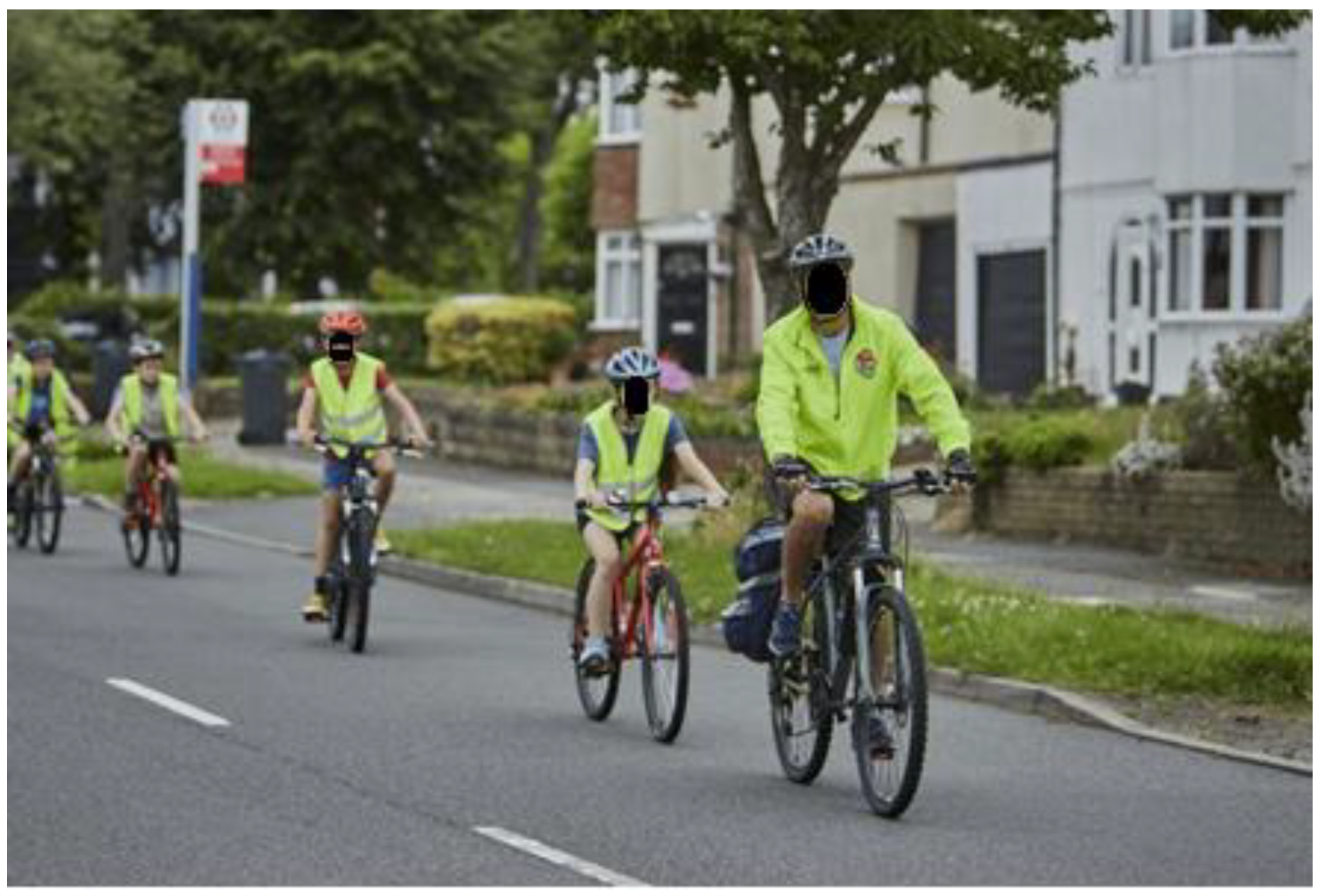
Figure 4. Practical exercises in the field conducted as part of Bikeability [15].
5. Austria
In Austria, road safety education is a mandatory component for children aged 6–18. Within the school environment, educators utilize educational materials from the Austrian Youth Red Cross to prepare children for the voluntary bicycle test. Furthermore, children engage in cycling classes within small groups, with a focus on acquiring safe traffic navigation skills. In Austria, children aged 10 and above have the opportunity to obtain a bicycle card, which grants them permission to cycle independently. Attaining this card involves successfully passing the voluntary Radfahrprüfung bicycle test, which consists of both a theoretical written component and a practical section conducted by Austrian police officers within an actual traffic environment. During the practical test, children navigate a designated route under the supervision of teaching staff, volunteers, the police, and parents, allowing them to demonstrate their skills in a secure setting. Typically, Austrian children undertake this examination at the age of 9, typically during the fourth grade of primary school. Alternatively, they have the option to schedule private testing appointments within a simulated traffic town [16][17].
To enhance preparedness for the voluntary bicycle test, Austria has introduced the online educational platform radfahrprüfung.at. This platform empowers children to practice the concepts learned in school and simulate an examination scenario. Additionally, an application named JRK Mobile Campus has been developed, offering structured training modules to facilitate effective learning. Each module includes visual aids such as photos and instructional videos. The application features flashcards designed to assess the student’s comprehension, and their progress in learning can be monitored at any point [16][17].
6. Slovenia
An illustrative instance of Slovenia’s initiatives aimed at enhancing road safety involves preparing children and adolescents for a bicycle examination. Typically, children aged 4–5 commence learning their initial cycling skills under the guidance of parents and caregivers. In Slovenia, the Ministry of National Education, Science, and Sport has issued a document titled “Concept of Bicycle Training and Bicycle Examination in Primary School.” This publication delineates objectives, content, methodologies, and modes of instruction related to educating students about cycling safely in road traffic [18][19]. Primary schools, parents, local councils organized for road traffic accident prevention and education, and the police collaborate to prepare students for independent cycling while also evaluating their driving skills. Teachers who have completed a seminar to serve as training program providers offered by the Institute of Education of the Republic of Slovenia design the training curriculum. The program encompasses three distinct segments:
-
Attaining theoretical knowledge and assessing comprehension.
-
Practicing cycling skills in controlled environments.
-
Experiencing hands-on riding within actual traffic scenarios [19].
The training framework follows a structured approach, commencing in grades 1–3 with the establishment of theoretical groundwork on road safety. The comprehensive document specifies the specific topics to be covered during these theoretical sessions. In the fourth and/or fifth grade, theoretical knowledge is revisited and reinforced, culminating in a theoretical exam that assesses familiarity with cyclists’ rights and traffic regulations. This assessment of theoretical knowledge utilizes a dedicated platform tailored for cyclists, generating questions of varying difficulty levels at random. Each participant responds to 20 questions, and the results are promptly disclosed upon completion of the test.
Practical training is scheduled for the fifth grade of primary school. This includes sessions in a designated maneuvering area, where children practice essential maneuvers, adherence to road rules, and the skill to inspect their bicycle’s technical condition. Subsequently, students transition to practicing in real traffic settings around the school, where they encounter diverse traffic scenarios within a safe environment. Each group, comprising five students and a teacher, participates in 3 to 5 h of training. Before practical sessions, thorough bicycle technical assessments are conducted, which include affixing a bicycle safety sticker, issuing a bicycle inspection report, and ensuring the bicycle is ready for use. Mandatory bicycle helmets are worn during these classes and reflective vests are also worn during practical training and the bicycle exam. Initially, students traverse the traffic practice route on foot, enabling them to internalize feedback and observations for later riding sessions. The practical examination begins with maneuvering area tasks, where students must successfully navigate at least five obstacles without touching a wheel or toppling structures. Subsequently, the examination progresses to real traffic scenarios in the school’s vicinity, mirroring the practice locations. The “Concept of Bicycle Training and Bicycle Examination in Primary School” document meticulously outlines the criteria for passing the individual components of the bicycle exam. Upon completion of the entire training regimen, children receive a bicycle card issued in the form of a document bearing signatures from both the school and parents. With this card, children gain the autonomy to independently participate in road traffic [19][20].
Slovenia demonstrates another commendable cycling practice through nationwide educational campaigns. One of these campaigns, the “Safe Bike” initiative, previously mentioned in the training protocol description, stands out. This program is integrated into the school system and specifically targets children aged 10–11 as well as their parents. As part of the bicycle training curriculum, students are obligated to undergo inspections of their bicycle’s technical condition before cycling. The campaign encompasses training in bicycle repair and maintenance while emphasizing safe riding practices through the use of appropriate equipment. Each spring, technical inspectors collaborate with the Slovenian Road Safety Council to conduct classes within schools, preparing bicycles for the upcoming season. Successful completion of the inspection earns participants a “Safe Bike” sticker. The sticker’s color changes annually, rendering the previous one invalid. To obtain a new sticker the following year, bicycles must undergo another inspection. If a bicycle fails to meet specific criteria, parents are notified about the necessary repairs. Frequently, parents take the initiative to address defects and arrange for the bike’s inspection, with their children closely involved. Implementing a “Safe Bike” campaign is straightforward and cost-effective, yet its outcomes are of paramount importance in bolstering cyclists’ safety [21].
Another widely promoted nationwide initiative is the “A Wise Head Wears a Helmet” project, which advocates for helmet usage among children and youth aged 6–17. Annually, the campaign distributes various informative leaflets and produces posters and brochures to disseminate the message. Furthermore, schools endorsing helmet use have the option to procure helmets with a safety certification issued by the Slovenian Road Safety Council at a special discounted rate. The overarching objective of the campaign is to popularize helmet wearing and enhance public consciousness about its pivotal role in enhancing cyclist safety on the road. This project is even equipped with its own website, developed in collaboration with the Ministry of Health [21].
7. Poland
In Poland, cycling education is integrated within the technology subject module in primary schools. Within these classes, children acquire skills for safe participation in road traffic as cyclists. They learn to interpret road signs, grasp bicycle maintenance techniques, and prepare their bicycles for safe riding. The core curriculum of this subject offers students an opportunity to obtain a bicycle card, which grants minors over the age of 10 permission to cycle independently. The curriculum suggests dedicating no more than 12 h to the content associated with preparing for this card. The examination for primary school students consists of both a theoretical and a practical component, conducted at a location designated by the school principal. A positive result in the theoretical segment requires achieving a minimum of 80% of the points. In the practical segment, a successful outcome necessitates correctly executing at least 90% of the maneuvers without posing a threat to road traffic. Moreover, individuals not enrolled in primary school have the option to undertake these activities at voivodship traffic centers and certified driver training centers that meet additional requirements [22].
Within the Polish examination system, educational institutions are responsible for developing regulations and procedures for acquiring a bicycle card (refer to Figure 5). A thorough analysis of these documents reveals noteworthy disparities in the training and examination of young cyclists. These differences manifest in several aspects:
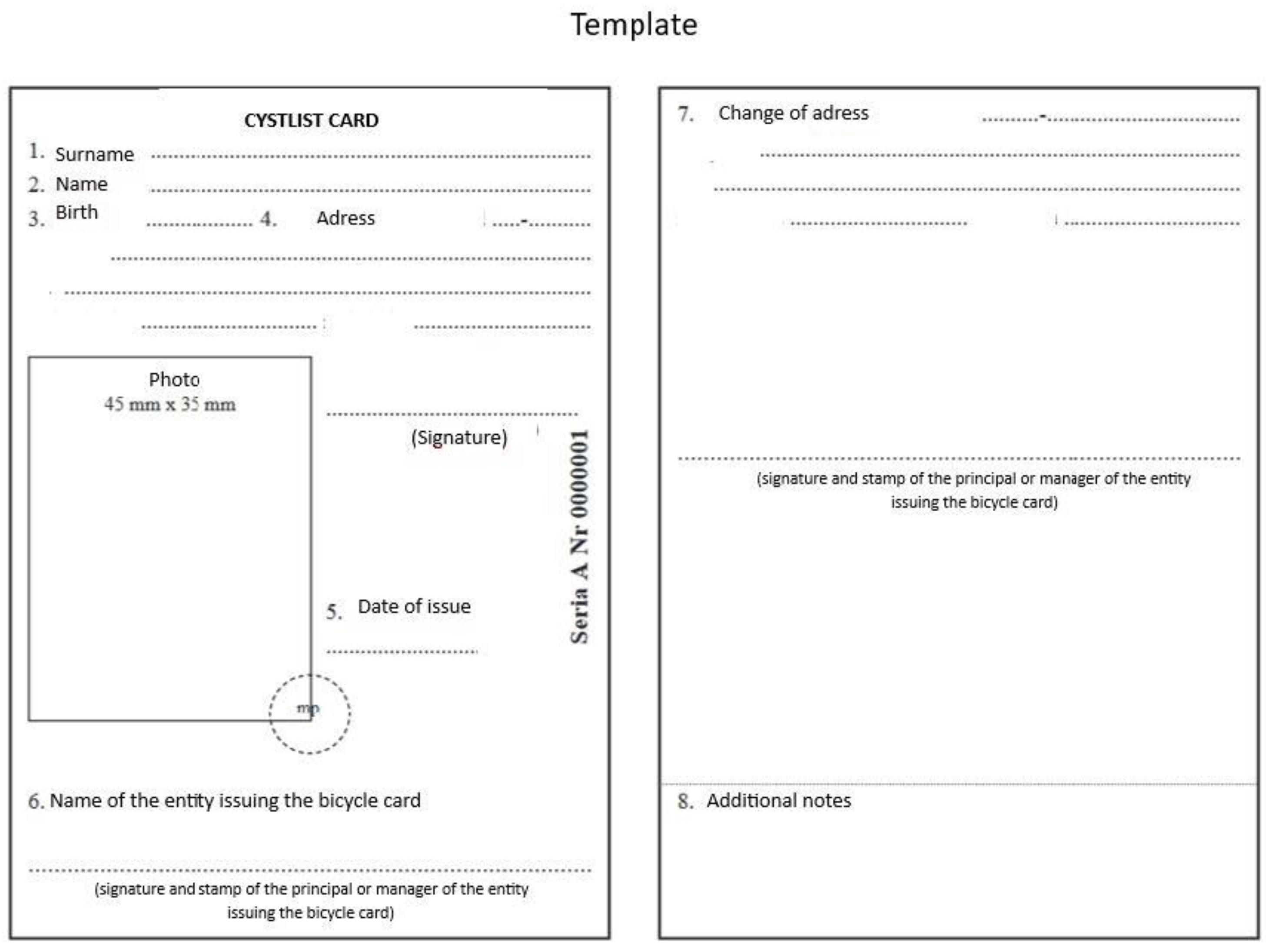
Figure 5. Template of Polish bicycle card [23].
-
The role of the coordinator and teaching staff assisting students in obtaining a bicycle card.
-
The curriculum content covered in preparation for acquiring a bicycle card.
-
The duration of each examination segment.
-
The format of the theoretical examination, encompassing question count and knowledge scope.
-
The location of the practical examination.
The specific skills students must demonstrate during the practical exam [23].
8. Italy
In Italy, Article 230 of the Highway Code [24] has introduced mandatory bicycle education in educational institutions of all levels, including artistic education institutes and nursery schools. The programs cover a range of topics, including knowledge about road safety principles, road structures, related signs, general vehicle conduct regulations with a specific focus on bicycle usage, and user conduct rules. Additionally, there is a particular focus on providing information on the risks associated with the consumption of psychotropic substances, narcotics, and alcoholic beverages. These courses can be organized by both public and private institutions, and they may involve collaborating teachers in program implementation.
Within this educational context, the Italian Federation for the Environment and Bicycles (FIAB), which has been recognized as an ONLUS association since 1998, plays an active role. Its primary objective is to promote the bicycle as an environmentally friendly mode of transportation, contributing to both urban and rural environmental revitalization [25].
The courses offered by FIAB are tailored to different age groups of young cyclists. For children aged 5 to 6, the course focuses on guiding them in observing their surrounding street environment and instilling appropriate behavior. For those aged 6 to 10, a five-year course comprising modules of four hours per year integrates the understanding of concepts such as signage, road safety, vehicle intermodality, and local geography, alongside the promotion of environmentally friendly practices. The course concludes with a final game and the issuance of a “good cyclist” license.
Children aged 11 to 13 engage in a road safety and sustainable mobility education course. For the first class, the course spans ten sessions over three years, and for the second class, it is condensed into six sessions over two years. Each module, involving six hours per year, covers various subjects ranging from the role of bicycles as a mode of transportation to an introduction to local cycle paths.
References
- International Law Commission. In Proceedings of the Vienna Convention on the Law of Treaties, Vienna, Austria, 23 May 1969.
- DaCoTA. Pedestrians and cyclists. In Deliverable 4.8l of the EC FP7 Project DaCoTA; DaCoTA: Bryn Mawr, PA, USA, 2012.
- OECD. Speed management. In Proceedings of the European Conference of Ministers of Transport, Paris, France, 1–3 January 2006.
- Ellis, J. Bicycle Safety Education for Children From a Developmental; National Highway Traffic Safety Administration: Washington, DC, USA, 2014.
- Holland-Cycling.com. Traffic Exam Improves Road Safety for Children. 2018. Available online: https://www.holland-cycling.com/blog/292-traffic-exam-improves-road-safety-for-children (accessed on 3 February 2023).
- Veiligverkeer Assen. Praktisch Verkeersexamen 2023. 2023. Available online: https://www.vvnassen.nl/Praktisch-verkeersexamen (accessed on 3 February 2023).
- Verkeer op School. Tien Weetjes over Het Grote Fietsexamen. 2021. Available online: https://www.verkeeropschool.be/nieuws/tien-weetjes-over-het-grote-fietsexamen/ (accessed on 7 February 2023).
- Wikipedia. Verkehrserziehung. 2022. Available online: https://de.wikipedia.org/wiki/Verkehrserziehung (accessed on 5 February 2023).
- Dojczland.info. Karta Rowerowa w Niemczech—Najważniejsze Informacje! 2020. Available online: https://dojczland.info/karta-rowerowa-w-niemczech/ (accessed on 5 January 2023).
- Wikipedia. Jugendverkehrsschule. Available online: https://de.wikipedia.org/wiki/Jugendverkehrsschule (accessed on 10 January 2023).
- Die Rheinpfalz. Jugendverkehrsschule: Radführerschein Auch in der Pandemie Möglich. 2020. Available online: www.rheinpfalz.de/lokal/kaiserslautern_artikel,-jugendverkehrsschule-radf%C3%BChrerschein-auch-in-der-pandemie-m%C3%B6glich-_arid,5132053.html?reduced=true (accessed on 8 January 2023).
- Deutshe Verkehrswacht. Über Uns. 2022. Available online: https://deutsche-verkehrswacht.de/ueber-uns/ (accessed on 8 January 2023).
- Department for Transport. National Standard for Cycle Training; Driver & Vehicle Standards Agency: London, UK, 2018.
- The Bikeability Trust. Bikeability Delivery Guide; The Bikeability Trust: Cambridge, MA, USA, 2022.
- Bikeability. About Us. 2020. Available online: https://www.bikeability.org.uk/about/ (accessed on 20 January 2023).
- Oesterreich.gv.at. Radfahrprüfung. 2022. Available online: https://www.oesterreich.gv.at/themen/freizeit_und_strassenverkehr/rad_fahren/1/Seite.610420.html (accessed on 14 January 2023).
- Jugendrotkreuz. Das Jugendrotkreuz im Kindergarten. 2021. Available online: https://www.jugendrotkreuz.at/oesterreich/angebote/radfahrpruefung/ (accessed on 14 January 2023).
- MeinBezirk.at. Jugendrotkreuz: Risiko für Badeunfälle Heuer Besonders Hoch. 2021. Available online: https://www.meinbezirk.at/perg/c-freizeit/jugendrotkreuz-risiko-fuer-badeunfaelle-heuer-besonders-hoch_a4746239#gallery=null (accessed on 15 January 2023).
- Javna Agencua Republike Slovenue Za Varnost Prometa. Kolesarski Izpiti. Available online: https://www.avp-rs.si/preventiva/prometna-vzgoja/programi/kolesarski-izpiti/ (accessed on 20 January 2023).
- Žlender, B. Koncept Usposabljanja za Vožnjo Kolesa in Kolesarskega Izpita v Osnovni Šoli; Ministrstvo za Izobraževanje, Znanost in Šport: Ljubljana, Slovenia, 2016.
- Weber, K. Inventory and Compiling of a European Good Practice Guide on Road Safety; European Commission: Brussels, Belgium, 2005.
- Ministerstwo Edukacji Narodowej. Podstawa Programowa Kształcenia Ogólnego z Komenatrzem: Szkoła Podstawowa, Technika; Dobra Szkoła: Warszaw, Poland, 2017.
- Minister Transportu, Budownictwa i Gospodarki Morskiej. Rozporządzenie Ministra Transportu, Budownictwa i Gospodarki Morskiej z Dnia 12 Kwietnia 2013 r. w Sprawie Uzyskiwania Karty Rowerowej (Dz.U. z 2013 r., Poz. 512); Sejm: Warszaw, Poland, 2013.
- Normattiva. Decreto Legislativo 30 Aprile 1992 n. 285 e Successive Modificazioni; Normattiva: Rome, Italy, 1992.
- Federazione Italiana Ambiente e Bicicletta. Chi Siamo. Available online: https://fiabitalia.it/fiab/chi-siamo/ (accessed on 18 March 2023).
More
Information
Subjects:
Transportation
Contributors
MDPI registered users' name will be linked to their SciProfiles pages. To register with us, please refer to https://encyclopedia.pub/register
:
View Times:
1.9K
Revisions:
2 times
(View History)
Update Date:
11 Oct 2023
Notice
You are not a member of the advisory board for this topic. If you want to update advisory board member profile, please contact office@encyclopedia.pub.
OK
Confirm
Only members of the Encyclopedia advisory board for this topic are allowed to note entries. Would you like to become an advisory board member of the Encyclopedia?
Yes
No
${ textCharacter }/${ maxCharacter }
Submit
Cancel
Back
Comments
${ item }
|
More
No more~
There is no comment~
${ textCharacter }/${ maxCharacter }
Submit
Cancel
${ selectedItem.replyTextCharacter }/${ selectedItem.replyMaxCharacter }
Submit
Cancel
Confirm
Are you sure to Delete?
Yes
No




